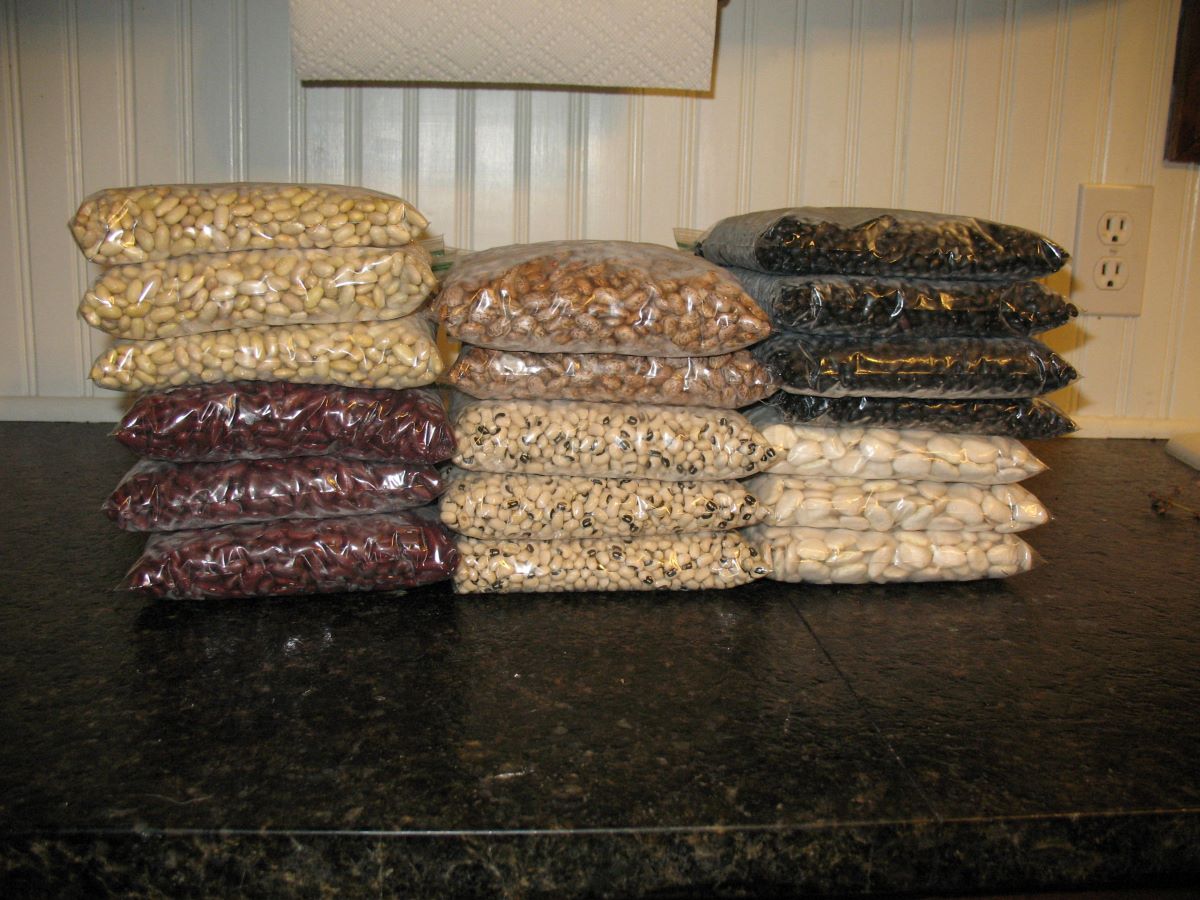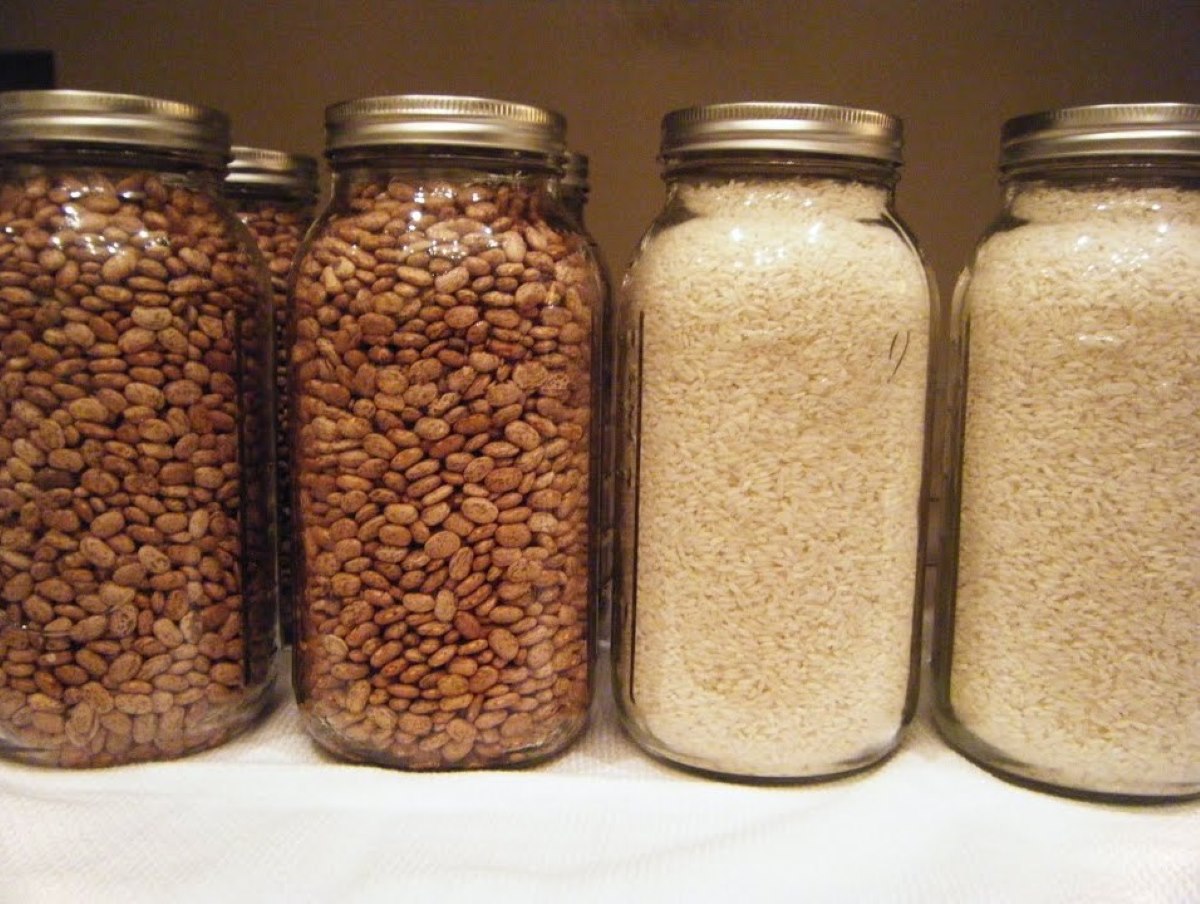

Articles
How To Store Rice And Beans Long Term
Modified: February 28, 2024
Learn the best methods for storing rice and beans long term in this informative article. Ensure your food supply remains fresh and accessible for years to come.
(Many of the links in this article redirect to a specific reviewed product. Your purchase of these products through affiliate links helps to generate commission for Storables.com, at no extra cost. Learn more)
Introduction
Storing rice and beans long term is not only a practical way to ensure a steady food supply, but it is also a cost-effective and convenient option. Rice and beans are staple pantry ingredients that not only provide essential nutrients but are also versatile and can be used in a variety of dishes.
Whether you are preparing for unexpected emergencies, looking to save money by buying in bulk, or simply want to have a well-stocked pantry, knowing how to store rice and beans properly is crucial to maintaining their quality and flavor over an extended period of time.
In this article, we will delve into the importance of storing rice and beans long term, discuss the factors to consider before storing them, explore the proper storage containers and materials to use, provide step-by-step instructions for storing them effectively, offer tips for monitoring and maintaining the stored rice and beans, and highlight the importance of managing pantry inventory and rotation.
By following these guidelines, you can ensure that your rice and beans retain their nutritional value, taste, and texture, making them reliable food sources for months or even years to come.
Key Takeaways:
- Stocking up on rice and beans for long-term storage ensures food security, cost savings, and dietary diversity. Proper storage, monitoring, and inventory management are essential for maintaining freshness and readiness.
- Selecting high-quality ingredients, using airtight containers, and implementing a FIFO system are crucial for preserving the quality of stored rice and beans. Regular inspections and restocking help minimize waste and ensure a well-prepared pantry.
Read more: How To Store Beans Long Term
Importance of Storing Rice and Beans Long Term
Storing rice and beans long term offers numerous benefits, making it a wise choice for any household. Here are some key reasons why it is important to store rice and beans for extended periods:
- Emergency Preparedness: Rice and beans are excellent sources of energy and essential nutrients. In times of natural disasters or emergencies when access to fresh food may be limited, having a stockpile of these pantry staples can provide a reliable and nutritious food source.
- Cost Savings: Buying rice and beans in bulk is often more cost-effective compared to purchasing smaller packages more frequently. Storing them long term allows you to take advantage of bulk buying opportunities and save money in the long run.
- Convenience and Availability: Life can be unpredictable, and having a well-stocked pantry with long-lasting food items like rice and beans ensures that you always have a backup plan. It eliminates the need for frequent grocery store visits and provides peace of mind knowing that your food supply is secure.
- Dietary Diversity: Rice and beans are versatile ingredients that can be used in a wide range of dishes. By storing them long term, you can incorporate these staples into your everyday meals, adding variety to your diet and ensuring a balanced nutrient intake.
- Food Security: As global food systems face challenges like climate change and disruptions in the supply chain, having a reliable stockpile of rice and beans can help buffer against potential food shortages or price fluctuations.
By recognizing the importance of storing rice and beans long term, you can take proactive steps towards ensuring food security, saving money, and being prepared for any unforeseen circumstances that may arise.
Factors to Consider Before Storing Rice and Beans
Before you start storing rice and beans for the long term, there are several important factors to consider. These factors will help you determine the optimal conditions and techniques for storing your pantry staples. Here are some key factors to keep in mind:
- Quality of Rice and Beans: Ensure that the rice and beans you plan to store are of high quality. Check for any signs of damage, pests, or moisture. It is recommended to choose dry, uncooked rice and beans with no broken or discolored grains.
- Storage Space: Evaluate the available storage space in your home. Determine whether you have enough room to store the desired quantity of rice and beans. Consider factors such as humidity, temperature, and accessibility.
- Longevity Requirements: Assess how long you need to store the rice and beans. Different storage techniques may be suitable for short-term storage (several months) versus long-term storage (one year or more). Take into account your specific needs and goals.
- Climate and Environmental Conditions: Consider the climate and environmental conditions in your area. Extreme temperatures, humidity, and exposure to light can negatively impact the quality of stored rice and beans. Choose storage methods that can mitigate these factors.
- Container Selection: Select appropriate containers for storing rice and beans. Ensure they are airtight, moisture-proof, and resistant to pests. Glass jars, plastic food storage containers, or food-grade buckets with tight-fitting lids are commonly used options.
- Labeling and Organization: It is important to label your storage containers with the date of storage and the contents inside. Establish a system to organize your pantry, ensuring that older batches are used first to minimize wastage.
- Pest Prevention: Take necessary precautions to prevent pests such as insects or rodents from infesting your stored rice and beans. This may include using insect-repellent methods or storing the containers off the ground and away from potential entry points.
Considering these factors before storing rice and beans long term will help you make informed decisions and create optimal conditions for preserving the quality and freshness of your pantry staples.
Proper Storage Containers and Materials
Choosing the right storage containers and materials is crucial for maintaining the quality and longevity of your stored rice and beans. Here are some key considerations when selecting the proper storage containers and materials:
- Airtight Containers: Opt for airtight containers to prevent moisture, air, and pests from entering. This helps to maintain the freshness and taste of your rice and beans. Glass jars, plastic food storage containers with tight-fitting lids, or food-grade buckets with rubber gaskets are suitable options.
- Moisture-Proof Materials: Ensure that the containers are made from moisture-proof materials to protect the rice and beans from humidity. Moisture can cause spoilage and the growth of mold and bacteria. Look for containers with a moisture barrier or use moisture-absorbing packets.
- Durable and Transparent: Choose containers that are durable and transparent. This allows you to see the contents easily, check for any signs of spoilage or pests, and rotate your stock effectively. Clear glass jars or food-grade plastic containers are ideal choices.
- Pest-Resistant: Consider containers that are resistant to pests. Ensure they have a tight seal and are made from materials that pests cannot easily chew through, such as thick plastic or glass. This helps to prevent insect or rodent infestation.
- Food Grade: Use food-grade containers that are safe for storing food. Avoid containers made from materials that may leach harmful chemicals into the rice and beans. Look for containers labeled as food-grade or those specifically designed for storing food.
- Ziplock Bags or Mylar Bags: Ziplock bags and Mylar bags can be used as additional layers of protection within larger containers. They provide an extra barrier against moisture and pests. Make sure to squeeze out any excess air before sealing them.
Remember to clean and dry your storage containers thoroughly before storing rice and beans to prevent any contamination. Additionally, it is important to store your containers in a cool, dry, and dark place to maintain the quality of the contents. By selecting the proper storage containers and materials, you can ensure that your rice and beans remain fresh and safe for an extended period.
Store rice and beans in airtight containers to keep out moisture and pests. Add oxygen absorbers to extend shelf life. Keep in a cool, dark place for best results.
Steps to Store Rice and Beans Long Term
Properly storing rice and beans long term requires following a few key steps to ensure their freshness and longevity. Here is a step-by-step guide to help you store your pantry staples effectively:
- Select High-Quality Rice and Beans: Choose dry, uncooked rice and beans that are in good condition, free from moisture, pests, and any signs of damage.
- Inspect and Clean Storage Containers: Thoroughly clean and dry your chosen storage containers. Make sure they are free from any dirt, dust, or residue that could contaminate the rice and beans.
- Portion and Package: Divide your rice and beans into manageable portions that you plan to use at one time. This makes it easier to access without exposing the entire supply to air and moisture. Package them tightly in airtight containers, leaving minimal headspace.
- Add Additional Layers of Protection: For added protection, consider using ziplock bags or Mylar bags as an extra layer within the main storage containers. Squeeze out any excess air before sealing them.
- Label and Date: Label each container with the date of storage and the type of rice and beans. This helps you keep track of the freshness and expiration dates.
- Store in a Cool and Dark Place: Find a suitable location in your home that is cool, dry, and dark to store the containers. Avoid areas that are exposed to direct sunlight, as it can accelerate the deterioration of the rice and beans.
- Monitor Temperature and Humidity: Regularly check the temperature and humidity levels in the storage area. Aim for a cool and dry environment to prevent moisture buildup and ensure the longevity of the stored rice and beans.
- Rotate and Use First-In, First-Out (FIFO) Method: Implement a rotation system to ensure that older batches of rice and beans are used first. This helps maintain freshness and prevent waste.
- Periodically Check for Signs of Spoilage or Pests: Regularly inspect the stored rice and beans for any signs of spoilage, pests, or moisture. If there are any concerns, discard the affected portion and take necessary measures to prevent further damage.
By following these steps, you can store your rice and beans long term with confidence, knowing that they will remain fresh, safe, and ready to use whenever you need them.
Read more: How To Store Coffee Beans Long Term
Monitoring and Maintenance of Stored Rice and Beans
Proper monitoring and maintenance are essential to ensure the quality and longevity of stored rice and beans. By regularly checking and taking necessary precautions, you can prevent spoilage, maintain freshness, and ensure the safety of your pantry staples. Here are some key steps to effectively monitor and maintain your stored rice and beans:
- Regular Inspection: Periodically inspect the stored rice and beans for any signs of spoilage, pests, or moisture. Check for unusual smells, discoloration, or the presence of insects or rodents.
- Maintain Ideal Conditions: Continuously monitor the storage environment, including temperature and humidity levels. Aim for a cool and dry location, ideally between 50°F to 70°F (10°C to 21°C) with humidity less than 15 to 20 percent.
- Air Circulation: Ensure that there is proper air circulation around the storage containers. This helps prevent the buildup of moisture and discourages the growth of mold and mildew.
- Rotate and Use FIFO Method: Implement a first-in, first-out (FIFO) system to use older batches of rice and beans first. This ensures that you are consuming the oldest stock and prevents the risk of items going past their expiration date.
- Pest Control: Take preventive measures to control pests. Regularly clean the storage area, seal any entry points, and use appropriate pest control methods or traps if necessary.
- Stock Rotation: As you use the stored rice and beans, replenish your supply with new purchases. This helps maintain a consistent stock and ensures that you always have a fresh batch of pantry staples available.
- Proper Handling: When accessing the stored rice and beans, use clean utensils and ensure that your hands are clean to prevent contamination. Reseal the containers tightly after each use.
- Regularly Check for Upgrades: Stay updated with the latest storage techniques and materials to improve the longevity of your pantry staples. Explore new methods or technologies that can increase their shelf life.
By proactively monitoring and maintaining the stored rice and beans, you can preserve their quality, flavor, and nutritional value, ensuring that they remain a reliable and safe food source for an extended period of time.
Managing Pantry Inventory and Rotation
Managing pantry inventory and rotation is essential to ensure that your stored rice and beans remain fresh, safe, and readily available when needed. By implementing an organized system, you can effectively track your inventory, use items before their expiration dates, and maintain a well-stocked pantry. Here are some key steps to manage pantry inventory and rotation:
- Inventory Tracking: Keep a detailed record of your pantry inventory, including the quantity, type of rice and beans, and their storage location. This allows you to easily track and manage your stock.
- Labeling and Date: Clearly label each container with the date of storage and the type of rice and beans. This helps you identify the oldest stock and use it first. Use a system to rotate items based on their expiration dates.
- Regular Inspection: Regularly inspect the quality and condition of the stored rice and beans. Check for any signs of spoilage, pests, or moisture. Discard any items that are no longer safe for consumption.
- Usage Planning: Plan your meals and cooking based on the stock in your pantry. Prioritize using the oldest items first to prevent waste and ensure that nothing goes beyond its expiration date.
- Restocking: As you use the stored rice and beans, replenish your inventory with new purchases. This helps maintain a consistent stock and ensures that you always have enough supply on hand.
- Regular Rotation: Implement a first-in, first-out (FIFO) system to ensure that the oldest stock is used first. Arrange your storage containers accordingly, placing the new stock at the back and the older stock at the front.
- Inventory Organization: Keep your pantry well-organized to easily access and identify items. Group similar types of rice and beans together and maintain clear aisles for easy visibility and rotation.
- Review and Adjust: Periodically review your inventory and adjust your purchasing habits accordingly. Consider factors like usage patterns, family size, and expiration dates to avoid excessive purchases and minimize waste.
- Educate Household Members: Inform and educate all household members about the pantry rotation system. Ensure everyone understands the importance of using items before their expiration dates and the FIFO method to maintain freshness.
By managing pantry inventory and rotation effectively, you can minimize food waste, maintain freshness, and ensure a well-stocked pantry that provides nutritious and reliable rice and beans for your household.
Conclusion
Storing rice and beans long term is a practical and cost-effective way to ensure a steady food supply and be prepared for unexpected situations. By following the proper storage techniques, monitoring the inventory, and implementing rotation systems, you can maintain the quality and freshness of your pantry staples for an extended period.
When considering storing rice and beans, it is essential to select high-quality ingredients and appropriate storage containers. Airtight, moisture-proof, and pest-resistant containers are highly recommended to keep your rice and beans safe from spoilage and pests.
Monitoring the storage environment, including temperature and humidity levels, is crucial to preserve the quality of the stored rice and beans. Regular inspections and preventive measures help prevent spoilage, pests, and moisture buildup.
Managing pantry inventory and rotation is key to using the oldest stock first and restocking with fresh purchases. By keeping an organized inventory, labeling containers with dates, and implementing the first-in, first-out (FIFO) method, you can ensure that your pantry staples are used in a timely manner, minimizing waste.
Properly storing rice and beans long term allows you to enjoy the benefits of emergency preparedness, cost savings, dietary diversity, and food security. Whether you’re facing unexpected situations or simply planning for the future, having a well-stocked pantry of rice and beans provides peace of mind.
Remember, regularly inspect and maintain your stored rice and beans, track your inventory, and use a system that prioritizes the oldest stock. By doing so, you can ensure that your rice and beans remain fresh, safe, and readily available to nourish you and your family in times of need.
So, stock up on rice and beans, choose suitable storage containers, create an organized system, and enjoy the long-lasting benefits of a well-prepared pantry!
Frequently Asked Questions about How To Store Rice And Beans Long Term
Was this page helpful?
At Storables.com, we guarantee accurate and reliable information. Our content, validated by Expert Board Contributors, is crafted following stringent Editorial Policies. We're committed to providing you with well-researched, expert-backed insights for all your informational needs.















0 thoughts on “How To Store Rice And Beans Long Term”